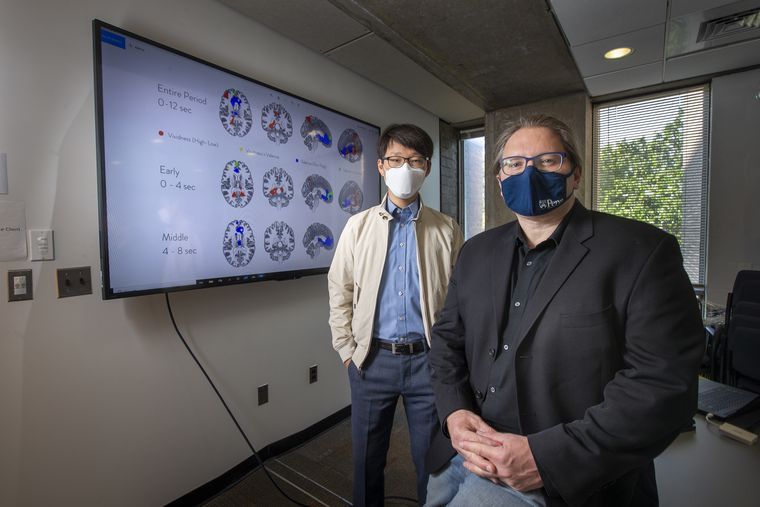Picture yourself winning the lottery. A telltale pattern of brain activity can be seen on an MRI machine.



It might be days before production resumes after an “organized cybersecurity attack” affected some servers supporting JBS USA’s North American and Australian IT systems, officials said.
CANBERRA, Australia — Thousands of meat workers had no work for a second day on Tuesday after a cyberattack crippled the world’s largest meat processing company. A government minister said it might be days before production resumes.
JBS is also Australia’s largest meat and food processing company, with 47 facilities across the country including abattoirs, feedlots and meat processing sites. JBS employs around 11000 people.
JBS USA said in a statement from Greeley, Colorado, on Monday that it was the target on Sunday of an “organized cybersecurity attack” affecting some of its servers supporting its North American and Australian IT systems.

A new map of what researchers call the “cosmic web” shows the dark matter in the local universe and reveals hidden “bridges” between galaxies.
(Credit: Getty Images)
The map, developed using machine learning, could enable studies about the nature of dark matter as well as about the history and future of our local universe.

A team at Stony Brook University used ORNL’s Summit supercomputer to model x-ray burst flames spreading across the surface of dense neutron stars.
At the heart of some of the smallest and densest stars in the universe lies nuclear matter that might exist in never-before-observed exotic phases. Neutron stars, which form when the cores of massive stars collapse in a luminous supernova explosion, are thought to contain matter at energies greater than what can be achieved in particle accelerator experiments, such as the ones at the Large Hadron Collider and the Relativistic Heavy Ion Collider.
Although scientists cannot recreate these extreme conditions on Earth, they can use neutron stars as ready-made laboratories to better understand exotic matter. Simulating neutron stars, many of which are only 12.5 miles in diameter but boast around 1.4 to 2 times the mass of our sun, can provide insight into the matter that might exist in their interiors and give clues as to how it behaves at such densities.
With 2700 locations across 10000 U.S. communities, YMCA is becoming a major hub for healthy living — From vaccinations and diabetes prevention programs, to healthy aging and wellness — Siva Balu, VP/Chief Information Officer — The Y of the U.S.A.
Mr. Siva Balu is Vice President and Chief Information Officer of YMCA of the U.S. (Y-USA), where he is working to rethink and reorganize the work of the organization’s information technology strategy to meet the changing needs of Y-USA and Ys throughout the country.
The YMCA is a leading nonprofit committed to strengthening community by connecting all people to their potential, purpose and each other, with a focus on empowering young people, improving health and well-being and inspiring action in and across communities, and with presence in 10000 neighborhoods across the nation, they have real ability to deliver positive change.
Mr. Balu has 20 years of healthcare technology experience in leadership roles for Blue Cross Blue Shield, the nation’s largest health insurer, which provides healthcare to over 107 million members—1 in 3 Americans. He most recently led the Enterprise Information Technology team at the Blue Cross Blue Shield Association (BCBSA), a national federation of Blue Cross and Blue Shield companies.
Mr. Balu was responsible for leading all aspects of IT, including architecture, application and product development, big data, business intelligence and data analytics, information security, project management, digital, infrastructure and operations. He has created several highly scalable innovative solutions that cater to the needs of members and patients throughout the country in all communities. He provided leadership in creating innovative solutions and adopting new technologies for national and international users.
5. Mars meteorite ALH 84001
These space “mushrooms” were not the first claim of alien life. On August 7, 1996, the then-President Bill Clinton stood on the White House lawn and announced the possibility that scientists had discovered the ancient, fossilized remains of micro-organisms in a meteorite that had been recovered from Antarctica in 1984.
The meteorite, ALH 84001, is one of a handful of rocks we have from Mars. These were blasted off the surface of the planet by volcanic eruptions or meteorite impacts, drifted through space probably for millions of years, before ending up on Earth.

In many species including humans, the cells responsible for reproduction, the germ cells, are often highly interconnected and share their cytoplasm. In the hermaphrodite nematode Caenorhabditis elegans, up to 500 germ cells are connected to each other in the gonad, the tissue that produces eggs and sperm. These cells are arranged around a central cytoplasmic “corridor” and exchange cytoplasmic material fostering cell growth, and ultimately produce oocytes ready to be fertilized.
In past studies, researchers have found that C. elegans gonads generate more germ cells than needed and that only half of them grow to become oocytes, while the rest shrink and die by physiological apoptosis, a programmed cell death that occurs in multicellular organisms. Now, scientists from the Biotechnology Center of the TU Dresden (BIOTEC), the Max Planck Institute of molecular Cell Biology and Genetics (MPI-CBG), the Cluster of Excellence Physics of Life (PoL) at the TU Dresden, the Max Planck Institute for the Physics of Complex Systems (MPI-PKS), the Flatiron Institute, NY, and the University of California, Berkeley, have found evidence to answer the question of what triggers this cell fate decision between life and death in the germline.
Prior studies revealed the genetic basis and biochemical signals that drive physiological cell death, but the mechanisms that select and initiate apoptosis in individual germ cells remained unclear. As germ cells mature along the gonad of the nematode, they first collectively grow in size and in volume homogenously. In the study just published in Nature Physics, the scientists show that this homogenous growth suddenly shifts to a heterogenous growth where some cells become bigger and some cells become smaller.

The inevitable has occurred. A piece of space debris too small to be tracked has hit and damaged part of the International Space Station — namely, the Canadarm2 robotic arm.
The instrument is still operational, but the object punctured the thermal blanket and damaged the boom beneath. It’s a sobering reminder that the low-Earth orbit’s space junk problem is a ticking time bomb.
Obviously space agencies around the world are aware of the space debris problem. Over 23000 pieces are being tracked in low-Earth orbit to help satellites and the ISS avoid collisions — but they’re all about the size of a softball or larger.

Germany will invest more than 8 billion euros ($9.74 billion) to fund large-scale hydrogen projects, the Economy and Transport ministries said on Friday, in a step to scale up hydrogen as an alternative to fossil fuels to meet climate targets.
The 62 German projects, supporting chemical, steel and transport industries, are part of a joint European hydrogen project called Hydrogen-IPCEI, the ministries added.
“The fact is: we must and WANT to urgently promote the switch to climate-friendly mobility,” said Transport Minister Andreas Scheuer in a statement.
